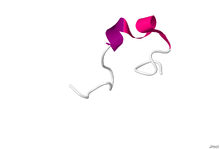- Obestatin
-
ghrelin/obestatin preprohormone 
Obestatin NMR structure in SDS / DPC micellar solution.[1] Identifiers Symbol GHRL Entrez 51738 HUGO 18129 OMIM 605353 RefSeq NM_016362 UniProt Q9UBU3 Other data Locus Chr. 3 p26-p25 Obestatin is a putative hormone that is potentially produced in the cells lining the stomach and small intestine of several mammals including humans.[2] Obestatin was originally identified as an anorectic peptide, but its effect on food intake remains controversial.[3]
Contents
Discovery
Research carried out at the Stanford University School of Medicine in 2005 identified obestatin as a new hormone with a bioinformatics approach by computer search of the sequenced genomes of several organisms.[4] As yet no biochemical studies of circulating obestatin have been carried out, and no secretory convertase is capable of cleaving the recombinant proghrelin precursor by cleavage at the single basic residue required for generation of the obestatin sequence. [5] Thus the physiological generation of this particular peptide sequence remains unproven.
Function and mechanism
Obestatin is a putative peptide hormone - a relatively small protein. It is encoded by the same gene that also encodes ghrelin, a peptide hormone that increases appetite. The protein produced by that gene breaks into two smaller peptides, ghrelin and obestatin. The purpose of this mechanism that produces two hormones with opposing effects remains unclear, however may explain earlier findings, namely that removing the ghrelin gene from mice did not significantly reduce their appetite.
Obestatin has been shown to antagonise growth hormone secretion and food intake induced by ghrelin.[3] It was originally proposed that GPR39 functioned as an obestatin receptor, however more recent findings suggest that this is unlikely.[6]
Clinical significance
Studies on the obestatin/ghrelin ratio in the gastrointestinal tract and plasma are associated with some diseases such as irritable bowel syndrome (IBS),[7] obesity,[8] Prader-Willi syndrome,[9] and type II diabetes mellitus.[10][11]
Structure
The Obestatin structure to the right was determined by NMR. The length of the polypeptide was found to be 24 residues with a secondary structure 29% helical. Specifically 2 helices and 7 residues are formed.[1]
See also
References
- ^ a b PDB 2JSH; Scrima M, Campiglia P, Esposito C, Gomez-Monterrey I, Novellino E, D'Ursi AM (November 2007). "Obestatin conformational features: a strategy to unveil obestatin's biological role?". Biochem. Biophys. Res. Commun. 363 (3): 500–5. doi:10.1016/j.bbrc.2007.08.200. PMID 17904104.
- ^ Gourcerol G, St-Pierre DH, Taché Y (June 2007). "Lack of obestatin effects on food intake: should obestatin be renamed ghrelin-associated peptide (GAP)?". Regul. Pept. 141 (1–3): 1–7. doi:10.1016/j.regpep.2006.12.023. PMID 17321609.
- ^ a b Hassouna R, Zizzari P, Tolle V (July 2010). "The ghrelin/obestatin balance in the physiological and pathological control of growth hormone secretion, body composition and food intake". J. Neuroendocrinol. 22 (7): 793–804. doi:10.1111/j.1365-2826.2010.02019.x. PMID 20456603.
- ^ Zhang JV, Ren PG, Avsian-Kretchmer O, Luo CW, Rauch R, Klein C, Hsueh AJ (November 2005). "Obestatin, a peptide encoded by the ghrelin gene, opposes ghrelin's effects on food intake". Science 310 (5750): 996–9. doi:10.1126/science.1117255. PMID 16284174. Lay summary – New York Times.
- ^ Ozawa A, Cai Y, Lindberg I (April 2007). "Production of bioactive peptides in an in vitro system". Anal Biochem 366 (2): 182–9. doi:10.1016/j.ab.2007.04.020. PMID 17540328.
- ^ Dong XY, He JM, Tang SQ, Li HY, Jiang QY, Zou XT (February 2009). "Is GPR39 the natural receptor of obestatin?". Peptides 30 (2): 431–8. doi:10.1016/j.peptides.2008.09.022. PMID 18977259.
- ^ Sjölund K, Ekman R, Wierup N (June 2010). "Covariation of plasma ghrelin and motilin in irritable bowel syndrome". Peptides 31 (6): 1109–12. doi:10.1016/j.peptides.2010.03.021. PMID 20338210.
- ^ Zhang N, Yuan C, Li Z, Li J, Li X, Li C, Li R, Wang SR (January 2011). "Meta-analysis of the relationship between obestatin and ghrelin levels and the ghrelin/obestatin ratio with respect to obesity". Am. J. Med. Sci. 341 (1): 48–55. doi:10.1097/MAJ.0b013e3181ec41ed. PMID 21139496.
- ^ Haqq AM, Muehlbauer M, Svetkey LP, Newgard CB, Purnell JQ, Grambow SC, Freemark MS (December 2007). "Altered distribution of adiponectin isoforms in children with Prader-Willi syndrome (PWS): association with insulin sensitivity and circulating satiety peptide hormones". Clin. Endocrinol. (Oxf) 67 (6): 944–51. doi:10.1111/j.1365-2265.2007.02991.x. PMC 2605973. PMID 17666087. http://www.pubmedcentral.nih.gov/articlerender.fcgi?tool=pmcentrez&artid=2605973.
- ^ Qi X, Li L, Yang G, Liu J, Li K, Tang Y, Liou H, Boden G (April 2007). "Circulating obestatin levels in normal subjects and in patients with impaired glucose regulation and type 2 diabetes mellitus". Clin. Endocrinol. (Oxf) 66 (4): 593–7. doi:10.1111/j.1365-2265.2007.02776.x. PMID 17371480.
- ^ Harsch IA, Koebnick C, Tasi AM, Hahn EG, Konturek PC (October 2009). "Ghrelin and obestatin levels in type 2 diabetic patients with and without delayed gastric emptying". Dig. Dis. Sci. 54 (10): 2161–6. doi:10.1007/s10620-008-0622-2. PMID 19082715.
Further reading
- Holst B, Egerod KL, Schild E et al. (2007). "GPR39 signaling is stimulated by zinc ions but not by obestatin". Endocrinology 148 (1): 13–20. doi:10.1210/en.2006-0933. PMID 16959833.
- Obestatin, A New Physiological Opponent of Ghrelin, PHOENIX PHARMACEUTICALS, INC.
External links
Categories:- Genes on chromosome 3
- Peptide hormones
- Obesity
Wikimedia Foundation. 2010.
